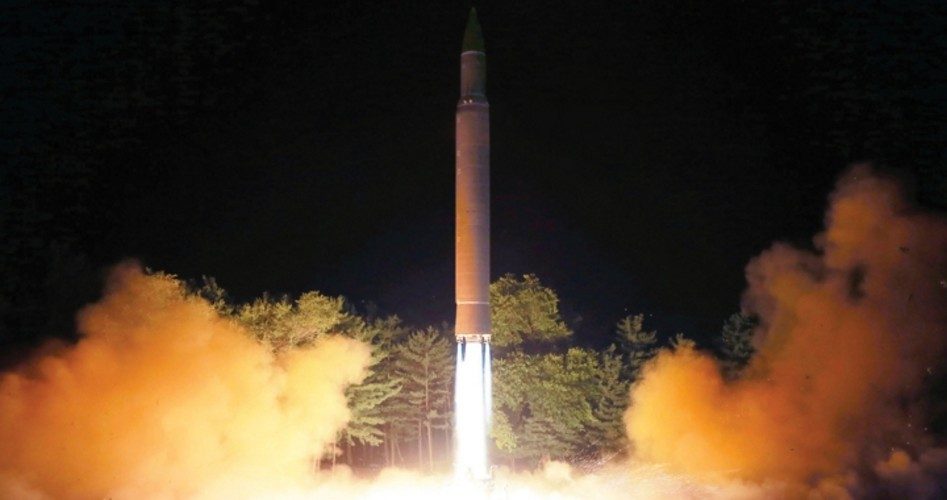
North Korea tested what has been described as an intercontinental ballistic missile (ICBM) on July 28 on a very high trajectory, bringing it down in the Sea of Japan. However, two missile experts quoted by CNBC stated that if this missile, believed to be a Hwasong-14, had been launched on a standard trajectory, it would have a range of close to 6,500 miles (10,400 kilometers), before accounting for the rotation of the Earth, which extends the range of missiles fired from west to east. Theoretically, such range would give the missile the capability of reaching a large portion of the United States, including Boston and New York.
CNBC spoke with David Wright, co-director and senior scientist for the Global Security Program at the Union of Concerned Scientists, who told the network: “Looks like it pretty much can get to New York, Boston and probably falls just short of Washington.” Wright is a physicist and technical arms control specialist.
Wright said the July 28 launch appears to show that North Korea can “go considerably farther” than missiles tested previously.
There is an unknown factor, however. Wright said it is still unclear if North Korea reduced the payload on the July 28 test to obtain a longer range than the test on July 4.
CNBC also quoted Bruce Klingner, former chief of the CIA’s Korea branch, and now senior research fellow for Northeast Asia at the Heritage Foundation’s Asian Studies Center. Klingner said: “Details are still preliminary, but it does look like the missile flew higher and for a longer duration than the July Fourth launch. It’s clearly an ICBM, and it would put more of the continental U.S. at risk.”
An August 1 Reuters report carried by the Alaska Dispatch News cited statements made by two U.S. intelligence officials, who spoke on condition of anonymity. They believe North Korea’s leader, Kim Jong-un, wants to develop a nuclear-capable ICBM to deter any attack on his country and gain international legitimacy, but not to launch an attack on the United States or its allies. The officials believe that Kim knows such an attack would be suicidal.
The report said the Pentagon declined to comment on the U.S. assessment of the missile launch, because such statements are classified.
“The specifics of our assessment are classified for reasons I hope you understand,” Pentagon spokesman Navy Captain Jeff Davis told a news briefing. Davis would only acknowledge only that the North Korean missile could fly at least 3,420 miles, the minimum range for what the Pentagon classifies as an ICBM.
Davis said that, while the test missile had a lofted trajectory rather than the more direct one required to reach the United States, the military takes the threat seriously.
“You could have the debate back and forth of whether the capability is proven or not, the fact of the matter is we take it seriously and we are prepared to defend against [it],” he said.
An August 1 report in the New York Post observed that President Trump has been frustrated by the inability of China, North Korea’s main trading partner, to rein in Kim’s weapons programs, tweeting on Monday that “China could easily solve this problem.”
Later, at a meeting of his Cabinet secretaries, Trump said his administration would “handle” the threat posed by the reclusive regime.
“We will handle North Korea. We are gonna be able to handle them. It will be handled. We handle everything,” Trump said.
Given the vagueness of Trump’s statement, “handling” the North Korean missile program could involve many options.
One such option, advocated by U.S. ambassador to the UN Nikki Haley, is calling for the UN Security Council to impose stronger sanctions against the Kim regime. On July 5, Haley delivered a statement to the Security Council saying, in part, “The international community has spoken frequently against the illegal and dangerous actions of the North Korean regime. For many years, there have been numerous UN sanctions against North Korea. But they have been insufficient to get them to change their destructive course.”
If existing UN sanctions have been “insufficient,” in Haley’s view, her obvious solution is to impose stronger sanctions.
However, as we noted in a July 26 article, even if the United States decided it was advisable to impose sanctions on North Korea it would still be advisable to do so unilaterally — not by means of the UN. Whenever our government relies on the UN for anything, whether it be economic warfare or actual military warfare, we are surrendering our sovereignty to the world body.
Consider the 36,516 American deaths in the UN-directed Korean War as a prime example of the consequences of becoming entangled with the UN.
Former Representative Ron Paul (R-Texas) suggested a non-interventionist solution to the problem of North Korea. “Here’s an alternative to doing the same thing over and over: Let’s take US troops out of North Korea after 70 years. The new South Korean president has proposed military talks with North Korea to try and reduce tensions. We should get out of the way and let them solve their own problems,” Paul said.
Of course, from the time of our nation’s founding, wise leaders, while advocating a non-interventionist foreign policy, also expressed the need for a strong national defense. In the case of North Korea, such a defense would include both a strong offensive force (to let Pyongyang know that any attack on the United States would mean their own destruction) as well as an effective missile-defense system capable of intercepting and destroying North Korean missiles before they can reach U.S. targets. The U.S. Missile Defense Agency (MDA) is currently testing ground-based interceptor missiles (GMD) capable of destroying an ICBM mid-flight. As we concluded in a June 9 article:
Though the development of a reliable GMD is certainly encouraging, no such system is 100-percent foolproof, especially against an attack involving multiple missiles and decoys. Therefore, a show of strength is the best deterrent against North Korea, and must include sending Pyongyang the message that the United States will not hesitate to use every tool in its arsenal against the communist state if it should provoke us with an attack. Might is something that even a power-mad tyrant such as Kim Jong-un can understand.
Photo of North Korean Hwasong-14 launch: AP Images
Related articles:
UN Ambassador Nikki Haley Says U.S. Talking With China About Sanctions on North Korea
South Korea Says North Korean ICBM Lacks Re-entry Capability
North Korea Claims Successful Intercontinental Ballistic Missile Test
U.S. Aircraft Carriers Gather Off N. Korea; Pyongyang Tests Missile Able to Hit Ships
In Test That Will Send Message to N. Korea, U.S. Successfully Intercepts ICBM
N. Korea Continues Missile Tests; U.S. Moves 3rd Carrier Strike Force to Western Pacific
North Korea Tests Another Missile, Says They Are Ready to Deploy
North Korea Tests Ballistic Missile Capable of Reaching U.S. Base on Guam
North Korea Threatens U.S. With “All Out War” and “Weekly Missile Tests”
North Korea’s Letter to Congress Says Pyongyang to Speed Up Nuke Program in Response to Sanctions
North Korea Threatens to Attack U.S. Carrier Group; Detains U.S. Citizen
North Korea Warns of Nuclear Retaliation at Any Sign of U.S. “Aggression”
North Korea Admits Missile Launches Were Test of Possible Strike Against U.S.Bases in Japan
North Korea Missile Test Draws Reactions From Trump, Abe, and UN
North Korea Claims to Test H-Bomb
North Korea Postures With Nuclear Warning, Movement of Missiles



